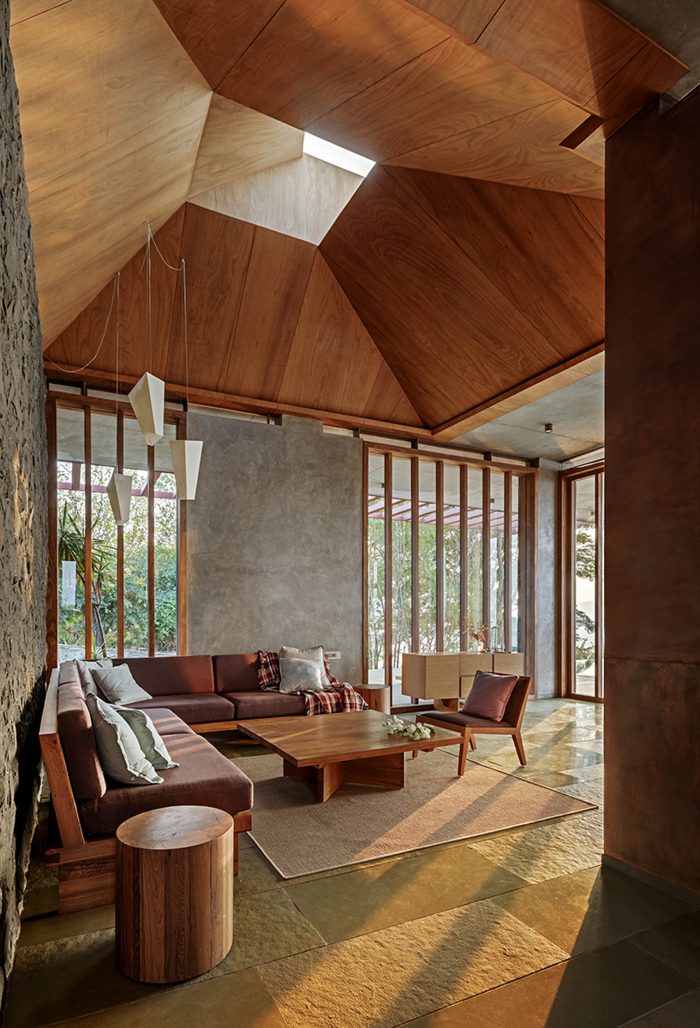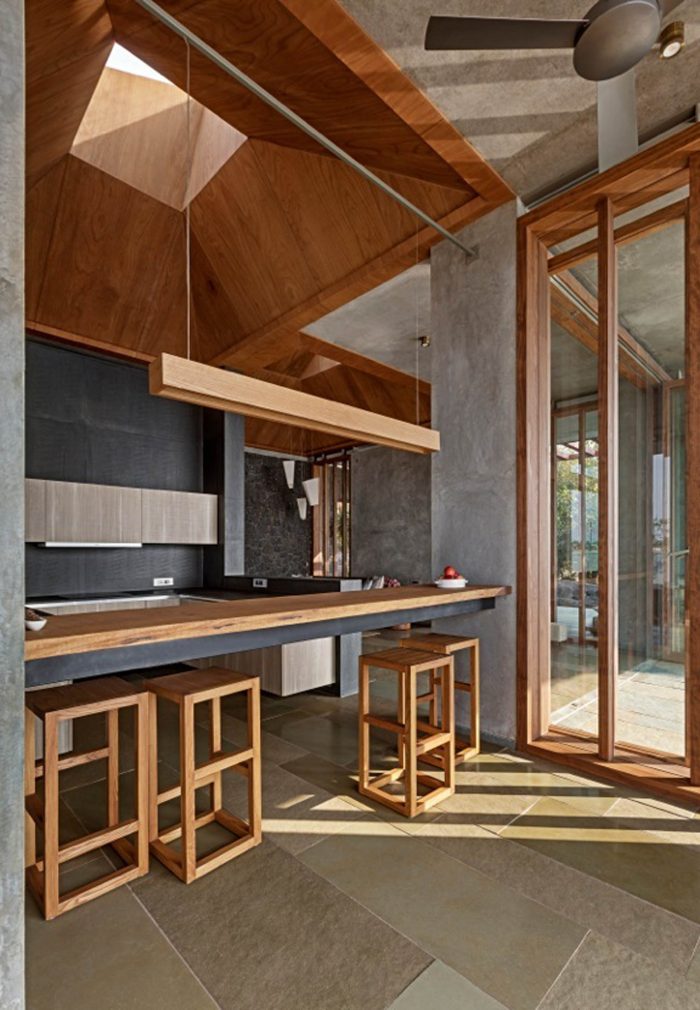我们风景如画的场地位于西高止山,栖息在湖泊的背水处,周围是萨哈德里山脉。
Our picturesque site is located in the Western Ghats perched on the backwaters of a lake and surrounded by the Sahyadri mountain ranges.
虽然他们拥有两英亩的土地,但我们客户的要求并不高。他们要求我们建造一个2100平方英尺的单层亭子,作为逃离孟买狂热的生活节奏和重振感官的休闲场所。
Although they owned two acres of land, our client’s requirements were modest. They asked us to build a 2100 sft single level pavilion as a retreat to escape the frenetic pace of Mumbai life and to reinvigorate the senses.
我们设想将单层亭子在空间上划分为两个主要区域,一个是白天与风景接触的区域,另一个则是夜晚安静的休憩场所。生活空间是外向的、可渗透的,允许自然渗透到它的包围圈中;私人空间是内向的、受保护的。
We envisioned a single level pavilion spatially subdivided onto two primary zones; one for engagement with the view during the day and the other as a quiet retreat at night. The living spaces are extroverted and permeable allowing nature to penetrate its envelope; the private spaces are introverted and protected.
亭子的挑战之一是不仅要从外围而且要将适当的自然光引入内部空间。为此,我们设计了一系列引人注目的天窗,以均匀地照亮内部空间。天窗的棱角形状的灵感来自于房子东西两侧山峰的轮廓。每一个天窗都将柔和的北面光线引入客厅、厨房、门厅和浴室。
One of the challenges of the pavilion was to admit the right quality of natural light not only from the periphery but also into its internal volumes. To this end, we created a series of dramatic skylights to illuminate the internal spaces evenly. The angular shapes of the skylights were inspired by the looming profiles of the mountain peaks to the east and west of the house. Each of the skylights admits a soft quality of north light into the Living, kitchen, foyer, and bathrooms
建筑物是用当地现成的黑色玄武岩石料建造的,这些石料是在地下5至6英尺处发现的。这种石头是火山石,在整个德干高原都有丰富的资源。我们在整个外墙的范围内和一些内部的重点墙面上使用了这种石材作为随机的干包覆层。
The architecture is built from the readily available local black basalt stone which was found on the site just 5 to 6 feet below ground. The stone is of volcanic origin and available in abundance across the Deccan Plateau. We used the stone as a random dry pack cladding along the entire extent of the exterior walls and on a few internal accent walls.
倾斜的土地让我们能够与该地的自然地形合作。我们没有创造一个分层的房子来适应斜坡,而是创造了一个挡土墙围墙和旁边的坡道,到达下面3′-6 “的入口。
The contoured land allowed us to work with the natural topography of the site. Rather than creating a split-level house to negotiate the slope, we created a retaining wall enclosure and a ramp alongside it to arrive at the entrance 3’-6” below.
我们不得不在家具和配饰方面进行大量的克制,选择定制每件物品,使其与建筑意图相协调。配件全部来自马哈拉施特拉邦,黄铜和铜器来自纳西克,Bidriware来自奥兰加巴德。
We had to exercise a great deal of restraint in the furniture and accessories, choosing to customize each piece to be in harmony with the architectural intent. Accessories were all sourced from Maharashtra, brass and copper vessels from Nasik and Bidriware from Aurangabad.
这座房子的主要目的是吸收自然环境,让自己向景色开放,但在这样做的过程中,我们必须保持对山上建筑的物理存在和环境影响的认知。
The primary objective of the house was to absorb the natural environment,to open itself up to the view.But in doing so we had to remain cognizantof the physical presence and the environmental impact of our architecture on the hill.
建筑师:Khosla Associates
年份:2017年
摄影:Shamanth Patil J
制造商:Accoya, Duravit, Grohe, Canwill Constructions, Ritikaa Woods, Shree Sai Baba Marbles
土木工程承包商:Canwill Constructions
负责人:Sandeep Khosla,Amaresh Anand
设计团队:Sandeep Khosla, Amaresh Anand, Oommen Thomas, Pratyusha Suryakanth, Moiz Faizulla
城市 : 坎南德万山
国家:印度
Architects: Khosla Associates
Year: 2017
Photographs: Shamanth Patil J
Manufacturers: Accoya, Duravit, Grohe, Canwill Constructions, Ritikaa Woods, Shree Sai Baba Marbles
Civil Contractor: Canwill Constructions.
Principals:Sandeep Khosla, Amaresh Anand
Design Team:Sandeep Khosla, Amaresh Anand, Oommen Thomas, Pratyusha Suryakanth, Moiz Faizulla
City:Kannan Devan Hills
Country:India




















